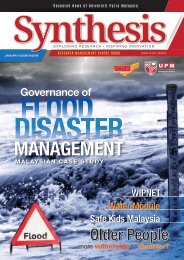SYNTHESIS 1/2020: CLIMATE CHANGE & DISEASE SHIFT IN MALAYSIA
Biomedical and health sciences research has always been the centre of focus in many countries for centuries. In fact, a portion of the tax-money has been allocated to research and development (R&D) in the country to improve the health and well-being of the people. The importance of R&D can be seen with the recent pandemic of COVID-19, which has swept the world with fear of the disease. Many parties are working together to curb the outbreak; healthcare providers nursing and treating the patients, scientists developing the virus detection system and vaccines, engineers creating tools for temperature detection and surface sanitising machine, and many more. All this expertise and creativity come from years of experience and hard work in R&D to create a better future for the nation and mankind.
Biomedical and health sciences research has always been the centre of focus in many countries for centuries. In fact, a portion of the tax-money has been allocated to research and development (R&D) in the country to improve the health and well-being of the people. The importance of R&D can be seen with the recent pandemic of COVID-19, which has swept the world with fear of the disease. Many parties are working together to curb the outbreak; healthcare providers nursing and treating the patients, scientists developing the virus detection system and vaccines, engineers creating tools for temperature detection and surface sanitising machine, and many more. All this expertise and creativity come from years of experience and hard work in R&D to create a better future for the nation and mankind.
You also want an ePaper? Increase the reach of your titles
YUMPU automatically turns print PDFs into web optimized ePapers that Google loves.
Social Science
Featured Articles
Socio-demographic factors
and body image perception are
associated with BMI-for-age
among children living in welfare
homes in Selangor, Malaysia
While obesity has become a major nutritional problem
worldwide, childhood obesity is a subject matter of priority
as it determines adulthood obesity and increases the risk of
adult morbidity and mortality. In a society where most adults,
as well as children and adolescents, are emphasising on
their ideal physical outlooks and always thinking about losing
weight, it is foreseeable that weight concerns and poor body
image perception are common.
Considering the double burden of malnutrition in Malaysia,
data on malnourished children living in welfare homes are
limited. There is a shift in the malnutrition trend among children
living in welfare homes from undernutrition to overnutrition
within the last seven years. This study aimed to determine the
body weight status of children living in welfare homes and its
associated factors.
A total of 307 children aged 7–17 years old living in 15 selected
welfare homes completed a standardised questionnaire, and
their body weights and heights were measured by trained
researchers. There were 54.4% orphans, 23.8% abandoned
children, and 21.8% children from problematic families. There
were 51.5% boys and 48.5% girls; 52.4% were Malays,
followed by 31.3% Indians, 12.7% Chinese, and 3.6% from
other ethnic groups.
About one in four of the children were facing overweight and
obesity problems (23.1%), whereas about one in ten of them
were thin and severely thin (8.5%). In bivariate analyses, sociodemographic
factors of age, sex, ethnicity, and welfare home
enrolment status, and psychological factors of self-esteem,
body shape dissatisfaction, and underestimation of body
weight status were significantly associated with body mass
index (BMI)-for-age. In the multiple linear regression analysis,
poor body image perception, being Malays or Chinese, and
having been abandoned significantly explained 39.7% of the
variances in higher BMI-for-age (F = 39.550; p < 0.05).
In short, dual forms of malnutrition existed among children
living in welfare homes, whereby the prevalence of overweight
and obesity was about three times higher than the prevalence
of thinness and severe thinness. These findings suggest the
need to have a regular assessment of body weight status
among children, and preventive actions should be taken by
the welfare homes’ related agencies and donors. Besides
the socio-demographic background, the current findings
emphasised the importance of incorporating body image
perception in an obesity prevention intervention program in
improving the nutritional status of the children living in welfare
homes.
• Dual forms of malnutrition existed among
children living in welfare homes.
• Overnutrition issue was more prevalent
than undernutrition issue among children
living in welfare homes.
• Besides socio-demographic background,
poor body image perception was an
important modifiable factor of higher BMIfor-age
among children living in welfare
homes in Selangor.
Corresponding Author:
Chin Yit Siew
Co-authors:
Nur Nabilla A Rahim
Norhasmah Sulaiman
Journal: Nutrients
Volume: 11
Issue: 1
Research grant: Universiti Putra
Malaysia (Putra Grant (GP-IPS)) grant
number GP-IPS/2014/9438732
Impact
factor
4.196
Quartile:
Q1 (2018)
SYNTHESIS 2020 | 19










